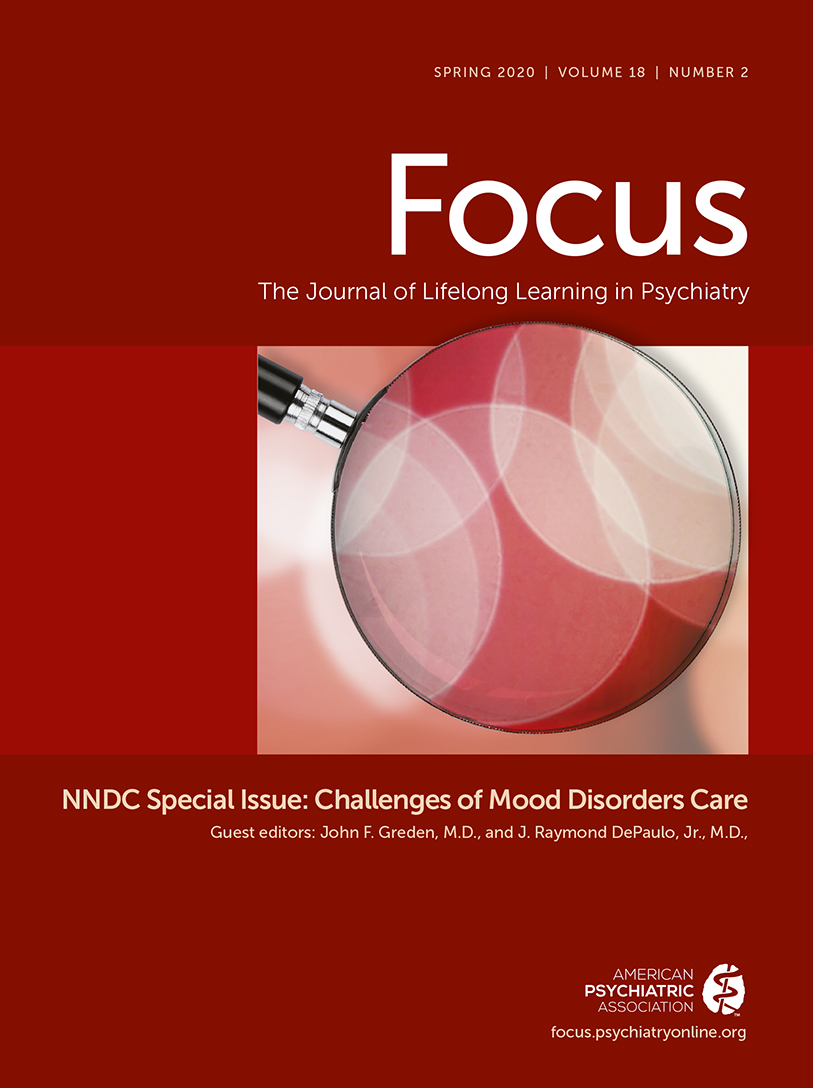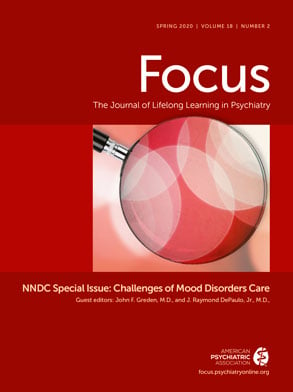Given space limitations and varying reprint permission policies, not all of the influential publications the editors considered reprinting in this issue could be included. This section contains abstracts from additional articles the editors deemed well worth reviewing.
Efficacy and Safety of Esketamine Nasal Spray Plus an Oral Antidepressant in Elderly Patients With Treatment-Resistant Depression—TRANSFORM-3
Ochs-Ross R, Daly EJ, Zhang Y, et al.
Am J Geriatr Psychiatry 2020; 28:121–141
BACKGROUND: Elderly patients with major depression have a poorer prognosis, are less responsive to treatment, and show greater functional decline compared with younger patients, highlighting the need for effective treatment.
METHODS: This phase 3 double-blind study randomized patients with treatment-resistant depression (TRD) ≥65 years (1:1) to flexibly dosed esketamine nasal spray and new oral antidepressant (esketamine/antidepressant) or new oral antidepressant and placebo nasal spray (antidepressant/placebo). The primary endpoint was change in the Montgomery-Åsberg Depression Rating Scale (MADRS) from baseline to day 28. Analyses included a preplanned analysis by age (65–74 versus≥75 years) and post hoc analyses including age at depression onset.
RESULTS: For the primary endpoint, the median-unbiased estimate of the treatment difference (95% CI) was −3.6 (−7.20, 0.07); weighted combination test using MMRM analyses z = 1.89, two-sided p = 0.059. Adjusted mean (95% CI) difference for change in MADRS score between treatment groups was −4.9 (−8.96, −0.89; t = −2.4, df = 127; two-sided nominal p = 0.017) for patients 65 to 74 years versus −0.4 (−10.38, 9.50; t = −0.09, two-sided nominal p = 0.930) for those ≥75 years, and −6.1 (−10.33, −1.81; t = −2.8, df = 127; two-sided nominal p = 0.006) for patients with depression onset <55 years and 3.1 (−4.51, 10.80; t = 0.8, two-sided nominal p = 0.407) for those ≥55 years. Patients who rolled over into the long-term open-label study showed continued improvement with esketamine following 4 additional treatment weeks.
CONCLUSIONS: Esketamine/antidepressant did not achieve statistical significance for the primary endpoint. Greater differences between treatment arms were seen for younger patients (65–74 years) and patients with earlier onset of depression (<55 years).
Copyright © 2019 The Authors. Published by Elsevier Inc. All rights reserved.
General Predictors and Moderators of Depression Remission: A VAST-D Report
Zisook S, Johnson GR, Tal I, et al.
Am J Psychiatry 2019; 176:348–357
OBJECTIVE: Almost two-thirds of patients with major depressive disorder do not achieve remission with initial treatments. Thus, identifying and providing effective, feasible, and safe “next-step” treatments are clinical imperatives. This study explores patient baseline features that might help clinicians select between commonly used next-step treatments.
METHODS: The authors used data from the U.S. Department of Veterans Affairs (VA) Augmentation and Switching Treatments for Improving Depression Outcomes (VAST-D) study, a multisite, randomized, single-blind trial of 1,522 Veterans Health Administration patients who did not have an adequate response to at least one course of antidepressant treatment meeting minimal standards for dosage and duration. For 12 weeks, participants received one of three possible next-step treatments: switch to another antidepressant-sustained-release bupropion; combination with another antidepressant-sustained-release bupropion; or augmentation with an antipsychotic-aripiprazole. Life table regression models were used to identify baseline characteristics associated with remission overall (general predictors) and their interaction with remission among the three treatment groups (moderators).
RESULTS: Remission was more likely for individuals who were employed, less severely and chronically depressed, less anxious, not experiencing complicated grief symptoms, did not experience childhood adversity, and had better quality of life and positive mental health. Two features suggested specific next-step treatment selections: age ≥65 years (for whom augmentation with aripiprazole was more effective than switch to bupropion) and severe mixed hypomanic symptoms (for which augmentation with aripiprazole and combination with bupropion were more effective than switch to bupropion).
CONCLUSIONS: If replicated, these preliminary findings could help clinicians determine which patients with depression requiring next-step treatment will benefit most from a specific augmentation, combination, or switching strategy.
Reprinted with permission from American Psychiatric Association Publishing.
Benefits of Sequentially Adding Cognitive-Behavioral Therapy or Antidepressant Medication for Adults With Nonremitting Depression
Dunlop BW, LoParo D, Kinkead B, et al.
Am J Psychiatry 2019; 176:275–286
OBJECTIVE: Adults with major depressive disorder frequently do not achieve remission with an initial treatment. Addition of psychotherapy for patients who do not achieve remission with antidepressant medication alone can target residual symptoms and protect against recurrence, but the utility of adding antidepressant medication after nonremission with cognitive-behavioral therapy (CBT) has received little study. The authors aimed to evaluate the acute and long-term outcomes resulting from both sequences of combination treatments.
METHODS: Previously untreated adults with major depression who were randomly assigned to receive escitalopram, duloxetine, or CBT monotherapy and completed 12 weeks of treatment without achieving remission entered an additional 12 weeks of combination treatment. For patients who did not achieve remission with CBT, escitalopram was added (CBT plus medication group) to their treatment, and for those who did not achieve remission with an antidepressant, CBT was added (medication plus CBT group) to their treatment. Patients who responded to the combination treatment entered an 18-month follow-up phase to assess risk of recurrence.
RESULTS: A total of 112 patients who did not achieve remission with a monotherapy entered combination treatment (41 who responded to monotherapy but did not achieve remission and 71 who did not respond to monotherapy). Overall, remission rates after subsequent combination therapy were significantly higher among patients who responded to monotherapy but did not achieve remission (61%) than among patients who did not respond to monotherapy (41%). Among patients who responded to monotherapy but did not achieve remission, the remission rate in the CBT plus medication group (89%) was higher than in the medication plus CBT group (53%). However, among patients whose depression did not respond to monotherapy, rates of response and remission were similar between the treatment arms. Higher levels of anxiety, both prior to monotherapy and prior to beginning combination treatment, predicted poorer outcomes for both treatment groups.
CONCLUSIONS: The order in which CBT and antidepressant medication were sequentially combined did not appear to affect outcomes. Addition of an antidepressant is an effective approach to treating residual symptoms for patients who do not achieve remission with CBT, as is adding CBT after antidepressant monotherapy. Patients who do not respond to one treatment modality warrant consideration for addition of the alternative modality.
Reprinted with permission from American Psychiatric Association Publishing.
Attenuation of Antidepressant Effects of Ketamine by Opioid Receptor Antagonism
Williams NR, Heifets B.D., Blasey C, et al.
Am J Psychiatry 2018; 175:1205–1215
OBJECTIVE: In addition to N-methyl-d-aspartate receptor antagonism, ketamine produces opioid system activation. The objective of this study was to determine whether opioid receptor antagonism prior to administration of intravenous ketamine attenuates its acute antidepressant or dissociative effects.
METHOD: In a proposed double-blind crossover study of 30 adults with treatment-resistant depression, the authors performed a planned interim analysis after studying 14 participants, 12 of whom completed both conditions in randomized order: placebo or 50 mg of naltrexone preceding intravenous infusion of 0.5 mg/kg of ketamine. Response was defined as a reduction ≥50% in score on the 17-item Hamilton Depression Rating Scale (HAM-D) score on postinfusion day 1.
RESULTS: In the interim analysis, seven of 12 adults with treatment-resistant depression met the response criterion during the ketamine plus placebo condition. Reductions in 6-item and 17-item HAM-D scores among participants in the ketamine plus naltrexone condition were significantly lower than those of participants in the ketamine plus placebo condition on postinfusion days 1 and 3. Secondary analysis of all participants who completed the placebo and naltrexone conditions, regardless of the robustness of response to ketamine, showed similar results. There were no differences in ketamine-induced dissociation between conditions. Because naltrexone dramatically blocked the antidepressant but not the dissociative effects of ketamine, the trial was halted at the interim analysis.
CONCLUSIONS: The findings suggest that ketamine's acute antidepressant effect requires opioid system activation. The dissociative effects of ketamine are not mediated by the opioid system, and they do not appear sufficient without the opioid effect to produce the acute antidepressant effects of ketamine in adults with treatment-resistant depression.
Reprinted with permission from American Psychiatric Association Publishing.
Mobile Apps for Mood Tracking: An Analysis of Features and User Reviews
Caldeira C, Chen Y, Chan L, et al.
AMIA Annu Symp Proc 2018; 2017:495–504
Many mood tracking apps are available on smartphone app stores, but little is known about their features and their users' experiences. To investigate commercially available mood tracking apps, we conducted an in-depth feature analysis of 32 apps, and performed a qualitative analysis of a set of user reviews. Informed by a widely adopted personal informatics framework, we conducted a feature analysis to investigate how these apps support four stages of selftracking: preparation, collection, reflection, and action; and found that mood tracking apps offer many features for the collection and reflection stages, but lack adequate support for the preparation and action stages. Through the qualitative analysis of user reviews, we found that users utilize mood tracking to learn about their mood patterns, improve their mood, and self-manage their mental illnesses. In this paper, we present our findings and discuss implications for mobile apps designed to enhance emotional wellness.
Copyright 2017. Reprinted with permission from AMIA.
Clinical Implementation of Pharmacogenetic Decision Support Tools for Antidepressant Drug Prescribing
Zeier Z, Carpenter LL, Kalin NH, et al.
Am J Psychiatry 2018; 175:873–886
The accrual and analysis of genomic sequencing data have identified specific genetic variants that are associated with major depressive disorder. Moreover, substantial investigations have been devoted to identifying gene-drug interactions that affect the response to antidepressant medications by modulating their pharmacokinetic or pharmacodynamic properties. Despite these advances, individual responses to antidepressants, as well as the unpredictability of adverse side effects, leave clinicians with an imprecise prescribing strategy that often relies on trial and error. These limitations have spawned several combinatorial pharmacogenetic testing products that are marketed to physicians. Typically, combinatorial pharmacogenetic decision support tools use algorithms to integrate multiple genetic variants and assemble the results into an easily interpretable report to guide prescribing of antidepressants and other psychotropic medications. The authors review the evidence base for several combinatorial pharmacogenetic decision support tools whose potential utility has been evaluated in clinical settings. They find that, at present, there are insufficient data to support the widespread use of combinatorial pharmacogenetic testing in clinical practice, although there are clinical situations in which the technology may be informative, particularly in predicting side effects.
Reprinted with permission from American Psychiatric Association Publishing.

